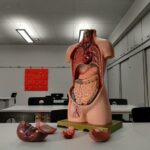If you’ve ever wondered what lies behind the adorable waddle and captivating eyes of a penguin, the answer might just be found in its mouth. In the fascinating world of these charismatic creatures, their beak-like appendage serves as a key tool for survival, enabling them to thrive in their icy habitats. Join us on a captivating journey as we unravel the intricacies of a penguin’s mouth, exploring its appearance and shedding light on its remarkable functionality.

Key Takeaways:
- A penguin’s mouth is unique, with pronounced growths called papillae that resemble sharp spines.
- These papillae cover the tongue, base, and roof of the penguin’s mouth and are made from soft keratin.
- The papillae in a penguin’s mouth serve as gripping tools for food and aid in directing it towards the mouth.
- The papillae also house taste cells, contributing to the penguin’s sense of taste.
- Penguins lack a traditional mouth and instead have a beak with a tough keratin coating.
- The beak is used for catching prey, while the papillae-covered tongue and base of the mouth manipulate and swallow food.
- Despite their appearance, the papillae are not particularly sharp or dangerous.
- The papillae provide a rough texture to the tongue, enabling penguins to grasp slippery food and swallow prey whole.
- The unique structure of a penguin’s mouth allows them to survive and thrive in their icy habitats.
What Does a Penguin’s Mouth Look Like Inside?
When it comes to the mouth of a penguin, their unique features might surprise you. Penguins have pronounced growths in their mouths called papillae, which resemble sharp spines. These papillae cover the tongue, base, and roof of the penguin’s mouth. Made from soft keratin, the same material found in human nails and hair, these spines are not particularly sharp or dangerous.
Papillae: Barbed Fish Hooks of the Penguin’s Mouth
The roof of a penguin’s mouth and its tongue are covered in rows of fleshy spines called papillae. These papillae bend inward toward the penguin’s throat, resembling barbed fish hooks. Looking inside a penguin’s mouth, one can see numerous papillae, functioning as gripping tools for food and aiding in directing it towards the mouth. Additionally, these papillae house taste cells, also known as taste buds, contributing to the penguin’s sense of taste.
Unlike humans and many other mammals, penguins do not have a traditional mouth. Instead, they possess a beak with a tough keratin coating. The beak serves as a specialized tool for catching prey in the ocean and is not involved in the eating process. Penguins rely on their papillae-covered tongue and base of the mouth to manipulate and swallow their food.
Papillae: Essential for Grasping Prey
Although the spines in a penguin’s mouth may seem intimidating, they are structurally similar to the papillae found in human mouths. These papillae provide a rough texture to the tongue and aid in grasping slippery food, allowing penguins to swallow their prey whole.
In conclusion, a penguin’s mouth is a unique structure with pronounced growths called papillae. These papillae resemble sharp spines and cover the tongue, base, and roof of the penguin’s mouth. Despite their appearance, the papillae are made from soft keratin and are not particularly sharp. They serve essential functions in gripping food and contributing to the penguin’s sense of taste. Penguins may lack a traditional mouth, but their beak and papillae-filled mouth enable them to survive and thrive in their icy habitats.
Sources:
1. Birdfact – Inside of a Penguin’s Mouth (All You Need To Know)
2. Squeaks and Nibbles – What Is Inside A Penguin’s Mouth?
Here are some fascinating topics with active internal links:
- Facts about a violin: Discover intriguing facts about the beautiful and melodic instrument that is the violin.
- Is carbon malleable: Delve into the world of carbon and learn about its surprising malleability.
- Forest food chain ecosystem: Explore the intricate web of life in the forest, from the tiniest insects to the towering trees.
- Food chain of a great white shark: Dive deep into the ocean and unravel the thrilling food chain of the majestic great white shark.
- Marine mammals word search: Dive into the depths of the sea and challenge yourself with a captivating word search focused on enchanting marine mammals.
- Visible stars word search: Embark on a celestial journey and test your knowledge of visible stars with an engaging word search.
- How long do dart frogs live: Uncover the secrets of dart frogs and learn about their surprisingly long lifespan.
- Boreal forest abiotic factors: Explore the unique abiotic factors that shape the enchanting boreal forest ecosystem.
- The food chain of a lion: Roam the savannah and witness the thrilling hunting prowess of the king of the jungle in its intricate food chain.
- How do gemstones work scientifically: Dive into the world of gemstones and unravel the scientific mechanisms behind their mesmerizing beauty.
- Label the parts of the wave: Ride the waves of knowledge as you explore and label the various parts of a wave.
- Atom model of sodium: Take a peek into the atomic world and marvel at the intricacies of the atom model of sodium.
- Birds of the savanna: Soar above the savanna and discover the diverse and captivating bird species that call this vibrant ecosystem home.
- Difference between male and female cardinals: Uncover the distinct features and behaviors that set the male and female cardinals apart in the avian world.
The Role of the Penguin’s Mouth in Feeding and Hunting
As we plunge into the depths of the icy polar regions, we uncover the mysteries of the penguin’s mouth—a vital tool in their quest for survival. Let’s embark on an expedition to explore the fascinating appearance and function of a penguin’s mouth, unraveling its secret role in feeding and hunting.
The Intricate Structure: Papillae, the Versatile Grippers
At first glance, a penguin’s mouth may appear unconventional, but it holds remarkable adaptations that aid in their feeding strategies. Instead of a traditional mouth, penguins possess a beak with a hard keratin exterior. However, it is what lies within that truly captivates us.
Inside the mouth of a penguin, we discover an array of spiny growths known as papillae. These papillae cover the tongue, base, and roof of the mouth, resembling the sharp spines of a mysterious creature from the depths. But what purpose do these spines serve?
A Marvelous Feeding Mechanism: The Papillae in Action
The distinguishing characteristic of a penguin’s mouth, the papillae, plays a crucial role in their feeding habits. These remarkable structures are not merely ornamentation, but rather an evolutionary adaptation that enhances the penguin’s feeding efficiency.
When a penguin hunts for its slippery prey, such as fish and squid, the papillae come into play. Acting as gripping instruments, these spines allow the penguin to firmly hold onto its fast-swimming meal. Without these papillae, the prey would easily slip from the penguin’s grasp, leaving it hungry and unfulfilled.
The Papillae: Enabling Survival and Ensuring Dietary Success
The presence of the papillae inside a penguin’s mouth is a testament to the unique adaptations these incredible creatures have developed to thrive in their icy habitats. By examining the inside of a penguin’s mouth, we gain valuable insights into their feeding strategies and dietary requirements.
The gripping capabilities of the papillae enable penguins to capture and consume their slippery prey effectively. These spiny structures provide a rough texture to the tongue, aiding in grasping and manipulating food. Without the papillae, penguins would struggle to secure their nourishment in the harsh and unforgiving marine environment.
Beyond Feeding: The Mouth as a Communication Channel
While we unravel the intricacies of a penguin’s mouth in relation to feeding and hunting, we must not disregard its role in communication. Penguins utilize their mouths not only to consume prey but also to communicate with one another.
Through a series of vocalizations, penguins convey messages to their fellow colony members using the various sounds produced in their mouth. Their beaks, with their unique shape and structure, enable them to emit calls that reverberate across their icy habitats, conveying information about their location or signaling warning signs.
Key Takeaways:
- Inside a penguin’s mouth, spiny growths called papillae play a vital role in capturing and consuming slippery prey.
- The papillae act as gripping instruments, allowing penguins to firmly hold onto their prey and prevent escape.
- The presence of papillae inside a penguin’s mouth is an evolutionary adaptation that enhances their feeding efficiency.
- By studying the structure and function of a penguin’s mouth, we gain insights into their feeding strategies and dietary requirements.
- Penguins utilize their mouths not only for feeding but also for communication within their colony.
Sources:, (Exploring the Hidden Landscape: Inside a Penguin’s Mouth)
The Presence of Sensory Organs in a Penguin’s Mouth
Penguins are remarkable creatures that have adapted to life in icy waters. One of the intriguing features of a penguin’s mouth is the presence of sensory organs known as papillae. These papillae are not only responsible for aiding in the penguin’s feeding process but also contribute to their sense of taste.
A Closer Look Inside a Penguin’s Mouth
When examining the inside of a penguin’s mouth, one cannot help but be captivated by the presence of large, spiky structures called papillae. These papillae cover various parts of the mouth, including the tongue, base, sides, and even the roof. Their rough texture is reminiscent of the papillae found in our own mouths. However, in the case of penguins, these structures are more prominent and play a crucial role in their survival.
The Functionality of Papillae
Papillae serve multiple purposes for penguins. Not only do they provide a gripping tool for capturing and holding onto prey, but they also aid in directing food towards the mouth. These spiny growths are made from soft keratin, similar to our nails and hair, allowing them to have a rough texture that assists in grasping slippery prey.
Sensory Organs in the Papillae
What sets the papillae in a penguin’s mouth apart is their role as sensory organs. These structures house taste cells, contributing to the penguin’s sense of taste. Through these papillae, penguins are able to distinguish between different flavors, ensuring they consume a diet suitable for their survival in their marine environment.
Understanding the Adaptation of Penguin Mouths
The presence of sensory organs in a penguin’s mouth is an adaptation that aids them in their feeding strategies. By studying the structure and functionality of a penguin’s mouth, we gain valuable insight into their dietary requirements and feeding habits. It provides a glimpse into how these remarkable creatures have evolved to thrive in their icy habitats.
Key Takeaways:
- Penguins have distinctive structures in their mouths called papillae, which are responsible for aiding in their feeding process.
- These papillae are made from soft keratin and give the tongue a rough texture, helping penguins grasp slippery prey.
- The papillae serve as sensory organs, housing taste cells that contribute to the penguins’ sense of taste.
- Understanding the presence of sensory organs in a penguin’s mouth provides insights into their feeding strategies and dietary requirements.
- The adaptation of a penguin’s mouth showcases their remarkable ability to survive and thrive in their marine environment.
Sources:
1. Hummingbirds Plus – Inside a Penguin’s Mouth: Exploring the Spines Called Papillae
2. The Birds World – What’s Inside Penguins Mouth? It’s Not What You Think!
Interaction of the Mouth with Other Physical Features of a Penguin
Penguins are fascinating creatures with unique physical features that enable them to thrive in their icy habitats. One of their most interesting features is their mouth, which plays a crucial role in capturing, manipulating, and swallowing prey. In this article, we will delve into the intricate interaction of a penguin’s mouth with other physical features, uncovering the secrets behind their feeding strategies.
The Structure of a Penguin’s Mouth
A penguin’s mouth consists of several components that work together harmoniously to facilitate their feeding process. Firstly, there is a duct connecting the mouth to the esophagus, allowing the smooth passage of prey from the mouth into the digestive system. This duct serves as a vital bridge between the mouth and the penguin’s internal organs.
Another important element of a penguin’s mouth is their tongue. Penguins have tongues covered in spiky structures called papillae. These papillae are made of soft keratin, much like human nails and hair. The papillae are not unique to penguins and can be found in other animals, including humans. In penguins, these papillae cover the tongue, base, roof, and sides of the mouth.
The Role of Papillae in a Penguin’s Mouth
So, what is the purpose of these spiky papillae? They serve as an essential tool for penguins when capturing and handling prey. The papillae provide a reliable grip, allowing the penguin to firmly hold onto slippery food. These structures enable penguins to efficiently grasp their prey and direct it towards their esophagus for swallowing.
The rough texture of the papillae on the penguin’s tongue aids in grasping slippery food, ensuring a secure hold. This characteristic is particularly important for penguins who rely on capturing fast-swimming prey in their marine environment. The papillae give the penguins an advantage in catching and consuming their slippery meals, enhancing their feeding efficiency.
Variations in Penguin’s Mouth Structure
While all penguins have spiny mouths and tongues covered in papillae, some variations in mouth structure can be observed between different species. These variations are adaptations to the unique feeding requirements and ecological niches of each species. By studying these structural variations, we can gain insights into penguins’ feeding strategies and dietary needs.
Key Takeaways:
- A penguin’s mouth consists of a duct connecting it to the esophagus, a tongue covered in papillae, and a bill or beak.
- The papillae are spiky structures made of soft keratin that cover the tongue, base, roof, and sides of a penguin’s mouth.
- Papillae in a penguin’s mouth provide a reliable grip when capturing and handling prey.
- Penguins use their papillae-covered tongue and base of the mouth to manipulate and swallow their food.
- There may be variations in the structure of penguin mouths between different species.
Citation:
1. BirdFact: Inside of a Penguin’s Mouth (All You Need To Know)
2. Hummingbirds Plus: Exploring the Hidden Landscape: Inside a Penguin’s Mouth

FAQ
Q1: What are papillae and where are they located in a penguin’s mouth?
A1: Papillae are spiky growths found in a penguin’s mouth. They cover the tongue, base, roof, and sides of the mouth, providing a rough texture and aiding in gripping slippery prey.
Q2: How do papillae in a penguin’s mouth help them capture prey?
A2: The papillae in a penguin’s mouth act as gripping tools, allowing them to firmly hold onto slippery prey like fish. They also help direct the food towards the mouth, aiding in the feeding process.
Q3: Are the papillae in a penguin’s mouth sharp or dangerous?
A3: Despite their sharp appearance, the papillae in a penguin’s mouth are made from soft keratin, similar to human nails and hair. They are not particularly sharp or dangerous.
Q4: Do all penguin species have the same type of mouth and papillae?
A4: Yes, as far as we know, all penguin species have mouths and tongues covered in spiny growths called papillae. While there may be structural variations between species, the presence of papillae is a common characteristic.
Q5: Can penguins bite with their beaks?
A5: Yes, penguins are capable of biting with their beaks. Although their mouths are not involved in the eating process, penguins can exhibit aggressive behavior and use their beaks to bite and stab, especially during fights with rival penguins.
- Unlock Ancient Roman Jewelry’s Secrets: History, Materials, & Symbolism Revealed - August 14, 2025
- Unveiling Ancient Roman Mythical Creatures: Legends, Powers & Origins Defined for Today’s Enthusiast - August 14, 2025
- Unlock Ancient Secrets: Ancient Roman Attire Women, Status, & Materials [Guide] - August 14, 2025
















